Heuvel van den, “Piet” Pieter.
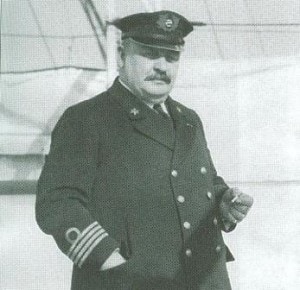
Pieter van den Heuvel, normally called Piet, was born on 25 Feb. 1870 in the town of Dordrecht, East of Rotterdam. His father was Jan Adrianus van den Heuvel and in the records of the Maritime Academy he is listed as Assistant Harbour Master. His mother was called Trientje, Gepke, Wilmina Kunst.
We have quite a bit of information of Captain van den Heuvel as he was one of the (few) captains who had a memoir. A Lady passenger/friend typed up his lifestory. (d)
There was a rumour in the newspapers during the First World war that v.d. Heuvel was born on a sailing ship but this was not true. His Grand Father , father and eight of his uncles (seven of which reached command) went to sea in sail. By the time Pieter was born his father was in command of a sailing ship, the “Anna Sanders” of 180 tons burden, carrying cargo on the South America service. Later on his father sailed on ships owned by other, where the profits might be lower but the income steady. And that income was needed as eventually there were seven children and all had to go to school. This when the father decided to sell his ship and move the whole family ashore so they could all be educated properly.
Not much else is known about the family but there seems to have been a brother who also went to sea and ended up as captain for the Rotterdam Lloyd, a Dutch Shipping Company trading between Rotterdam and the Dutch East Indies.
After deciding that he wanted to go to sea he attended the “Kweekschool voor de Zeevaart” in Amsterdam. Why he decided for Amsterdam is a question as Dordrecht and Rotterdam also had a navigation school but Amsterdam was considered the toughest, if not the best, and cadets from there never had a problem in finding a job. He is accepted on 13 August 1886 and enrolled in the three years course, which means that his previous education was short on mathematics. His memoirs indicate that he did not enjoy the discipline very much and was constantly in hot water about not following the rules and consequently had to stay in for all his free afternoons. He was however not kicked out as his school marks were very good.
On 30 Dec. 1886 he is placed on board the sailing ship ” J.Pot” sailing from Dordrecht as cadet with a wages of Fl. 10,– a month. His first voyage is a 82 day trip to New York which took so long as the captain took the southern route to avoid the North Atlantic Winter weather.
On 10 January 1887 he is signed off from this ship with a very good report. Then he is placed on the ship “Marij sailing from Rotterdam as cadet with a wage of fl 16,– He returns on 14 April 1888 with a very good report and that concludes his apprentice ship. On 14 April 1888 he passes the exam for 3rd mate and is discharged from the Academy on 17 July 1888 with very good reports. (b)
Then on 18 July 1888 he joined the Holland America Line. He was signed on as fourth officer on the Rotterdam (II). He was promoted to Chief Officer in four years time.
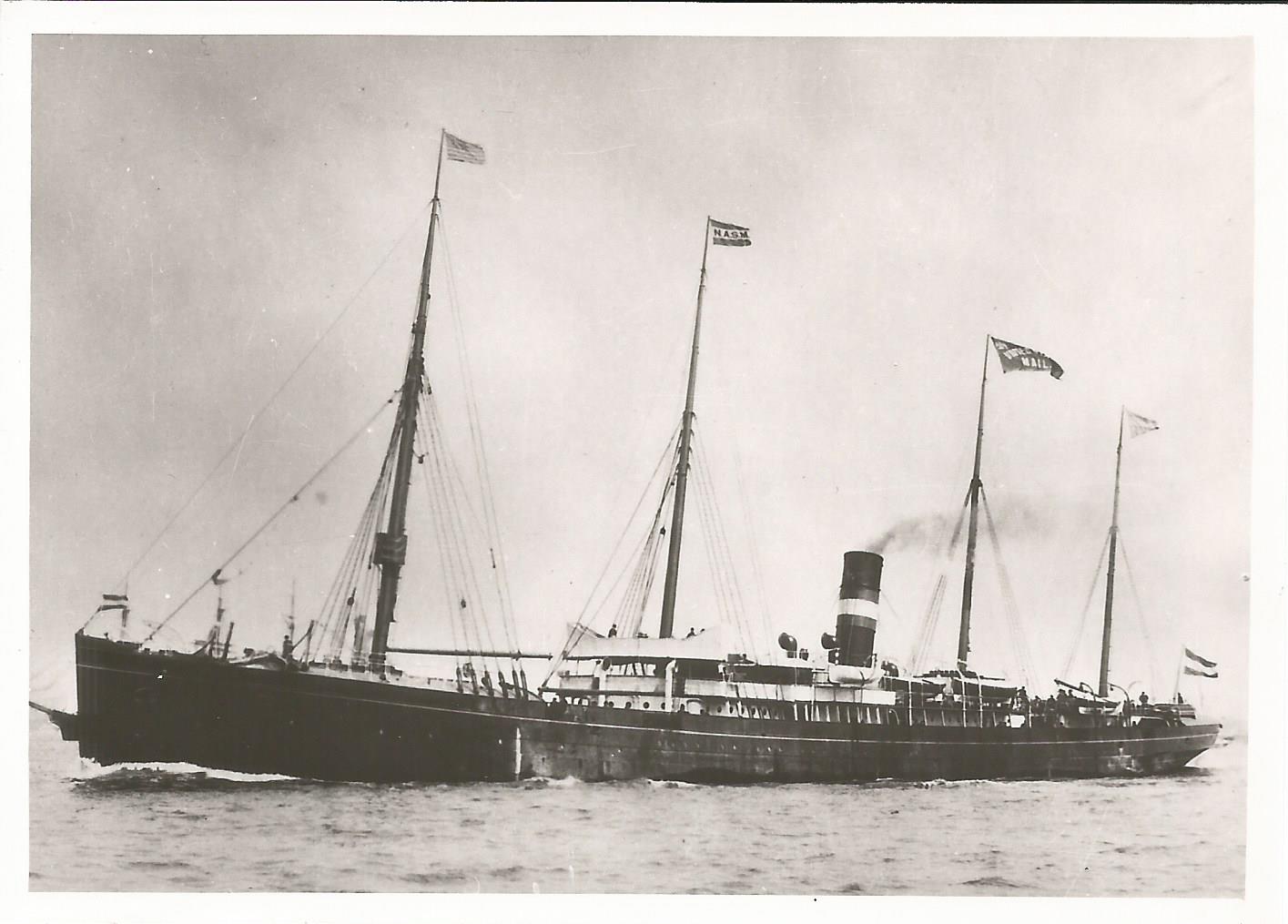
This is the ss Rotterdam (II), the first ship of 4th. officer van den Heuvel. She was one of several near sisters sailing the express service to New York. The ss Veendam (I) , ss Werkendam (I) , ss Amsterdam (II) and ss Spaardam (I) were he sailed on later were similar.In 1892/1893 he sails on the ss Didam and ss Dubbeldam, two ships which had been specially built by the company for their new South America service. A revolution in Argentina put a stop these plans and the two ships ended up on the service to New York. due to the large coal capacity needed for the long ocean voyage to South America, their cargo space was limited and thus their profitability. They were sold in 1895.
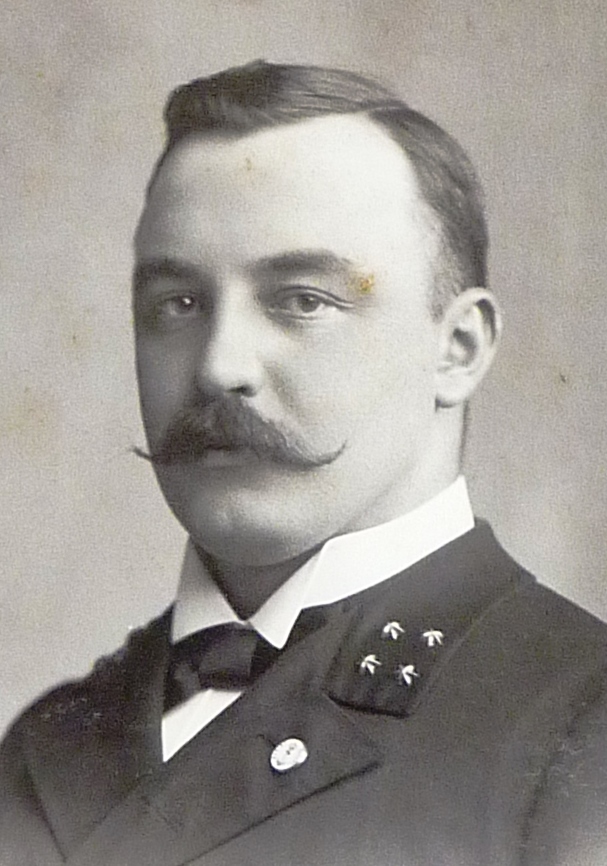
Chief Officer Van den Heuvel. The four pips on the lapel indicate the rank of First or Chief Officer. The dot (button) under it indicate Royal Navy reserve.
By that time he had already been transferred to the larger ships. In 1895 he was on board the ss Rotterdam (II) again. Now as Chief Officer and under the command of the company’s Commodore Captain Bonjer the ship sailed to Copenhagen and from there to the opening of the Kieler Kanal. (Officially the Nord – Ost See Kanal) This was the first cruise of the company but was then still called an Excursion with 400 participants. Two years later this ship was renamed in Edam (III) as a new Rotterdam (III) entered service on which was assigned Chief Officer in 1900. By now he was the Sr. Chief Officer in the fleet and waiting for a gap in the promotion list. He served for a month on the ss Rotterdam (III) and was then sent to Germany to collect the new ss Potsdam together with Commodore Bonjer.
Just before this assignment he had married in 1899 Lucie Danielle Gesine van Nordheim in his home town.
In June 1901 he is promoted to (acting) captain and ends up on a passengership the ms Maasdam (II) This was not company policy as he was much too junior, but Captain Willem Bakker had to go ashore for one voyage and Van den Heuvel was slotted in. Then normality was restored and his first regular command was the cargoship, ss Amsteldijk (I) This ship was brand new and he was sent out to West Hartlepool in England to collect her. Holland America was in the middle of an expansion program and that meant more ships and thus faster promotion.
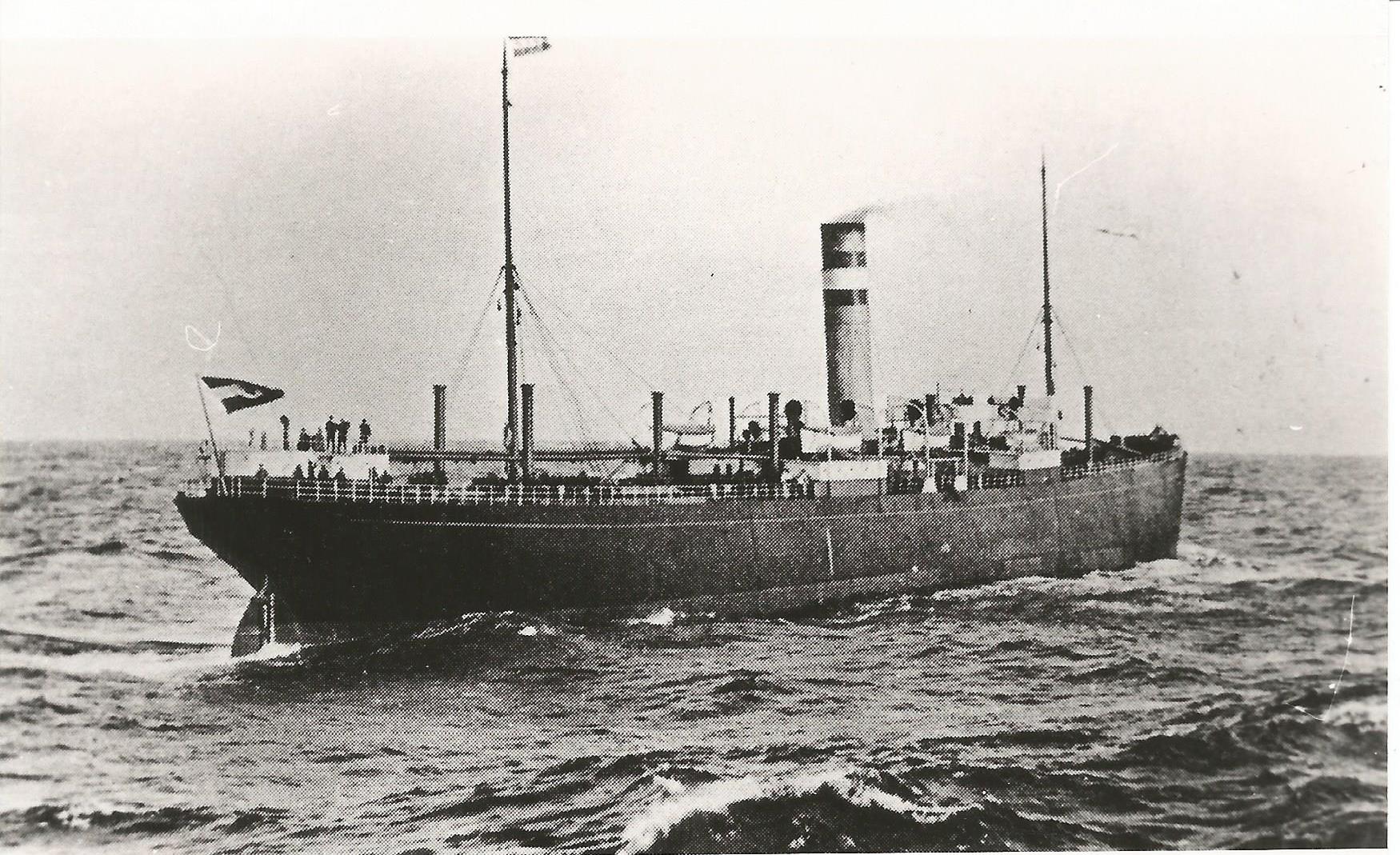
The ss Amsteldijk (I) If one looks at the stern of the ship one can see a rondel in the center of the flag. This indicates the captain is a Royal Netherlands Navy Reserve Officer, so it could be that Van den Heuvel was on board.
In 1910 he is captain of the ss Statendam (I) for its last two voyages of which the very last one is a 6 week cruise to the Holy Land from Rotterdam. On board about 800 Germans whose main focus was on the Inauguration of a Church in Jaffa. While preparing for departure in Rotterdam, a German Officer, called Graf Larosee, Adjutant of his Royal Highness, decked out in gold and with a tall Bearskin hat. After correctly saluting, clicking of heels included, he demanded the attention of our captain who told him to wait as taking out the ship came first. Then the message came out: The captain was expected to move from the head of his captains table as that space was ofcourse now reserved for His Royal Highness. The Captain indicated that he was not planning to give up his chair on his ship. This was met with total disbelieve by the Officer. As the captain did not give an inch, the Officer eventually capitulated and settled for the chair in the center of the (long)table as long as it then could be called the head of the table. To which the captain remarked: “Look to the forward end of the ship, we call that a bow, but if you want to call that the stern than I do not mind that at all”

Most photos known of the captain are with female passengers. here we see him on the ss Rotterdam (IV) during voyage 133, dDep. 23 August 1927 with first class passenger Helen Warnecke (see inset) (e)
The last voyage on the ss Rotterdam (IV) of the Commodore was a mixed bag. The first three days he had nice weather and then it was just bad. He could have arrived early in Rotterdam but decided to slow down a little bit, so he could swing on the Ebb tide near the terminal. Then the ship could dock nose out to open sea. Ready for his successor to sail straight out, without having to make the swing first.
Commodore van den Heuvel was unusual compared to many of his colleagues as there is a biography of him. Compiled by an American Lady called Mrs. Gelsey Taylor Frothingham, so we can get a glimpse into his working life.
He sailed continuously through the first world war (quite a few of the ships were laid up in this period and thus plenty captains available, so this was more unusual than it seems –ED). During the war he sailed on the Rijndam (I) and later on the Nieuw Amsterdam (I). At a certain moment he was the last captain still sailing as the Nieuw Amsterdam (I) was the only ship kept in regular service for the company, as the country needed the grain that the ship delivered each voyage.
According to the Commodore the new Statendam (III) was a great ship. The company could use two more of them to deal with all the interest it generated. Those who did not select the fast ships for a quick crossing, invariably preferred the Statendam for its cosiness.
After 42 years at sea, there were several anecdotes to tell: He was extremely proud to advise that in all his years he had not lost a single passenger while sailing. Something, that was, due to the small ships of the early years, not that usual. Quote: “The old Schiedam and Zaandam (I) took 14 days to get to the other side but now we do it in a week. With these ships barely measuring 3000 tons, the seawater could easily wash over the decks with a rolling ship. An unaware passenger could then easily slip and slide over the side.” Unquote.
The worst experience of the captain was running on a mine with the Rijndam (I). (18 January 1916) However London could be reached and the ship did not sink. There the cargo was re-stowed so the ship was more in balance again and then the voyage was continued to Rotterdam for repairs.
Bad weather was not unusual either. During one storm the ss Prins Willem sank in the English channel (23 January 1910 with 54 people on board) and he was very close behind it, but survived.
Another story was about a lady. The captain had just arrived with the Rijndam in Rotterdam and was taking the little ferry boat from the HAL pier to the north shore of the river Maas. (This ferry is called Heen en Weer in Dutch, which translates in To and From,….. what basically the function of a ferry is) While on the ferry, he saw a lady that he had also seen on the Rijndam. So he asked her, if she indeed had come over with the Rijndam. “Yes indeed” she said. Then she said: “I thought I saw you on board as well, did you travel First Class”? “No” said the Captain, “I am part of the crew”. “Oh” said the lady, “now I recognize you, you are the Ships Barber “ ………………..
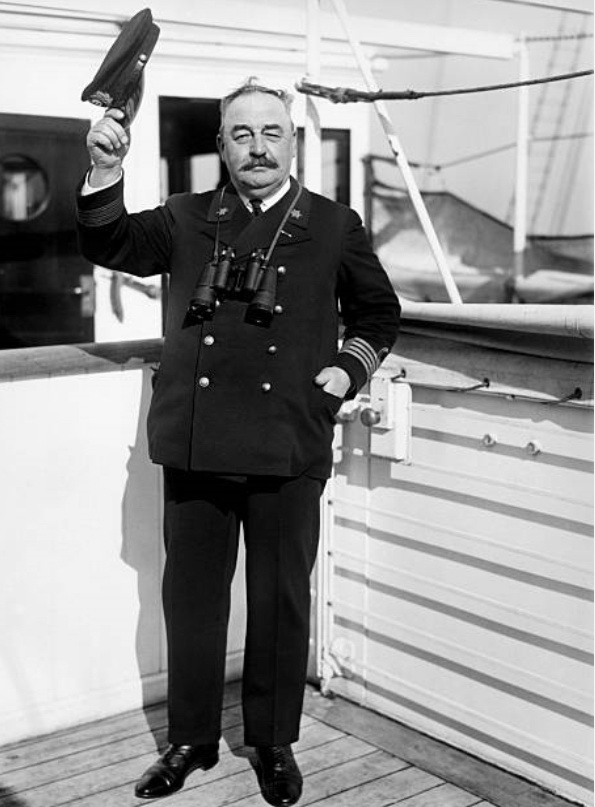
Captain Piet van den Heuvel on the Bridge during one of his last crossings.
Another little story, this happened in New York. The captain went ashore to send a telegram and was in his civvies but happened to be wearing his uniform cap, when he saw a man walking there with a very large suitcase.
This gentleman inquired in a very brusque voice, “is that the Rijndam”. “Yes”, said the captain, “would you like me to carry your suitcase”. “ Yes, but only if you are careful”. So he carried the suitcase onto the ship for him and received a quarter as payment. While just underway, he saw this brusque passenger looking at me totally perplexed and understood that he wanted to apologize. But he kept avoiding the man for the next three days. Then finally he managed to corner the captain. He said, I think that I have seen you before. The captain said, “Yes, I think you did and I also think that I know why you want to see me”. But you will not get your quarter back”. The man’s face was a picture to behold…………….
In total he made 298 voyages to New York and five cruises. Also he sailed for seven years as commodore for the company, First on the Nieuw Amsterdam (I), then on the Rotterdam (V) and for the last 7 voyages on the Statendam (III)
In June 1928 he made is 200rd crossing to New York while in command of the ss Rotterdam (IV) . In the next month he was 40 years with the company and received the gold medal from the company.
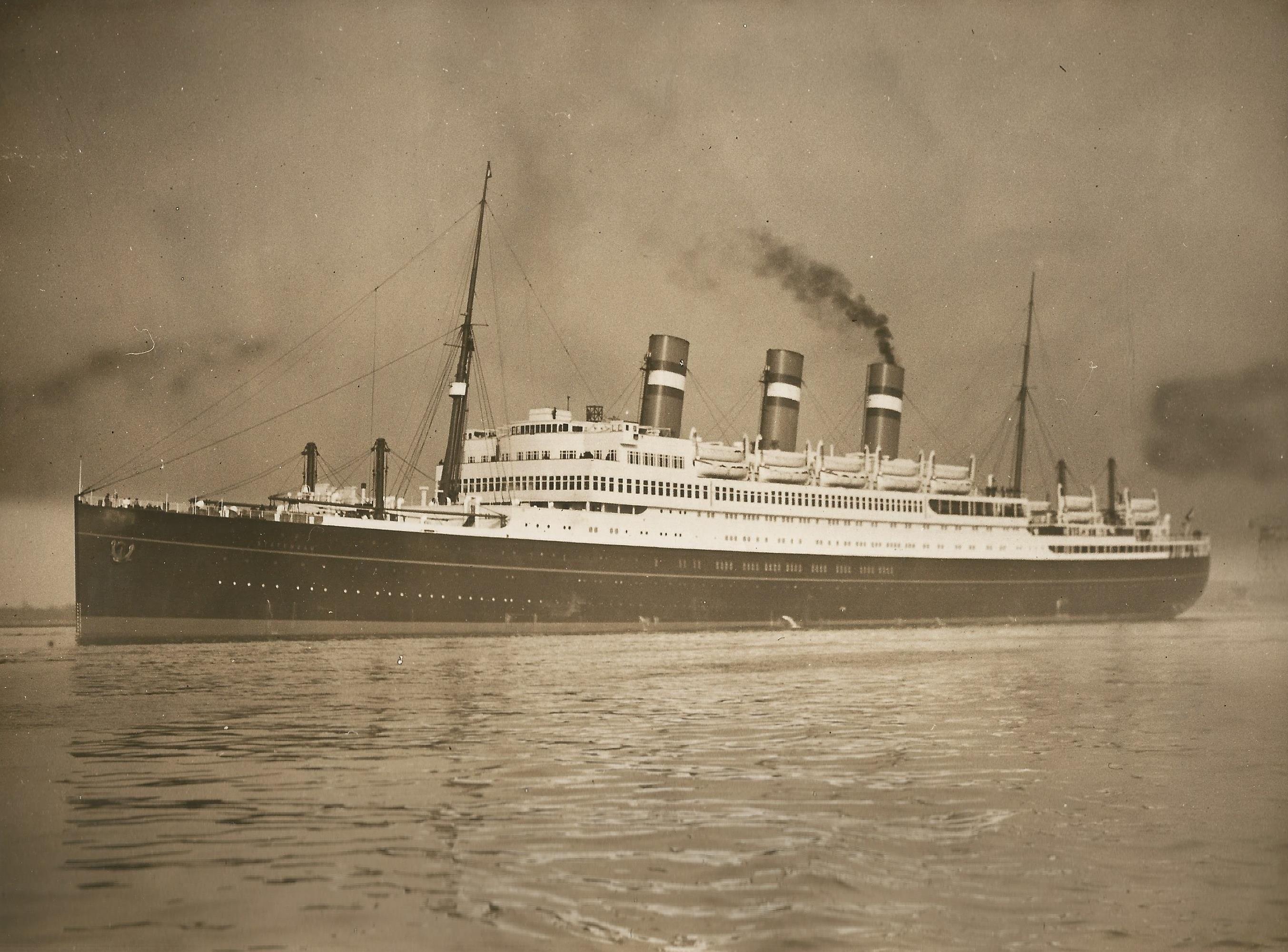
The ss Statendam (III) came into service in April 1929. She was similar in design and layout to the Statendam (II) which was torpedoed during the First World War while under British Flag as the ss Justicia.
In April 1929 he was assigned to the new Flagship of the company the ss Statendam (III) and took her on her maiden voyage on 11 April 1929. The officers calculated that he must have sailed at least 197800 sea miles during that period.
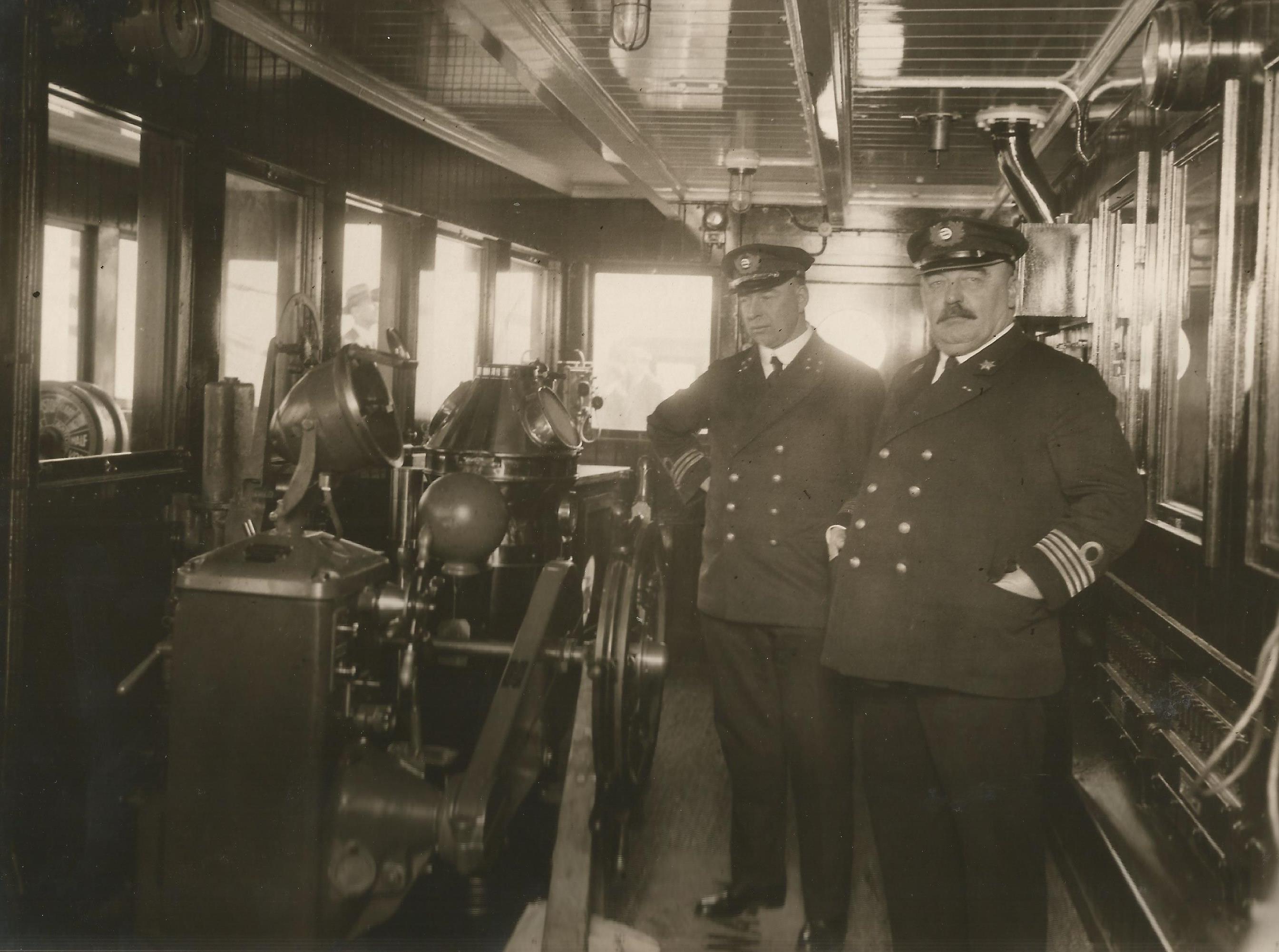
Commodore Piet van den Heuvel on the bridge of the ss Statendam (III) during the official trial trip before the hand over to Holland America . Next to him Chief Officer Coster who would 15 years later also become Commodore of the company.
During his last voyage, on the Statendam (III), there was quite a commotion on the ship. The stock exchange in New York had suffered a second big dip. Many of the passengers inundated the radio officers with telegrams. There was a bit of a problem with sending all these messages, as all the shore stations were continuously busy with telegrams from other ships who said similar challenges. Thus it was not easy for the radio officers to get through. A few passengers advised the captain, that millions were riding on their telegrams. However the Radio officers could not do very much; if they could not make the connection with the shore station and neither could the captain of course.
After his final arrival in Rotterdam on 28 November 1929 it was time to retire and to make room for a new captain, who was appointed Commodore at the same time. This was Captain Krol, who was scheduled to leave with the Statendam on 7 December 1929 for the next voyage. As the retiring Commodore said: “Le Roi et mort, vivre Le Roi.”
The captain retired in Holland to the town of Wassenaar. However he was planning to travel on a regular basis to the States. Although his home was in Holland, most of his friends lived in the States, due to the fact that while docked in New York, there was the time to socialize and go out. Upon retirement he had made 298 roundtrips to the USA of which 218 as Captain. Before his retirement he had been made a Knight in the Order of Orange Nassau, by the Dutch Government, for services to the Maritime Industry. (This is comparable to an OBE in the British System. In the Dutch System, an Officer (who can command a Knight, is higher in the pecking order than a Knight who can not necessary command an officer)
In May 1930 he pops up again in a Dutch newspaper as he was present during the Premiere showing of a HAL travel movie showing the ss Rotterdam (IV) going to Europe with 500 American Pax. on board. The Captain reveals here that the magic number 500 was derived at because otherwise a: the shore excursions could not cope and b. because most passengers were brought by company arranged luxury car (or other transport) to the port. The company tried to do their best for their guests but sometimes the old and the new world clashed. In Seville, Spain, everybody was taken to a Bull fight which was considered to bloody for the Americans so they all walked out. Then then upset the locals due to the lack of respect for their culture.
His main observation was that he was always amazed about the Americans who came to Europe to see as many ruins possible. On one side , this was understandable as there are not that many ruins in the USA, on the other hand, if you had to live in a ruins, as many local in the middle East had, you would be very happy to have a sturdy modern house instead.
Captain Van Den Heuvel passed away pm 24 June 1940 at the age of 70 years at his home in the town of Wassenaar. He was buried on the 26th. at the local cemetery Nieuw Eyck en Duynen.
Sailing List: (a)
Date: Function: Ship: Wages and/or remarks.
18 Jul. 1888 4th. Officer Rotterdam 20,–
09 Oct. 1888 4th. Officer Veendam 20,– via Queensborough to Liverpool
18 Jan. 1889 3rd. officer Veendam 30,–
29 Oct. 1889 3rd officer Zaandam 60.—
02 Nov. 1889 3rd officer Veendam 50,–
09 Dec. 1889 3rd officer Werkendam 50,–
30 Dec. 1889 Temporary dismissed to go to school for 2nd mates license. Passed exam 12 march 1900
19 Mar. 1890 3rd officer Spaarndam 55,–
08 May.1890 2nd Officer Spaarndam 70,–
23 Oct. 1891 2nd Officer Veendam 70,–
21 Jan. 1892 Temporary dismissed to go school for first mates license. Passed exam 14 Dec. 1892
03 Feb. 1892 2nd Officer Didam 70,–
21 Jul. 1892 Temporary dismissed.
17 Dec. 1892 Act. Chief Officer Dubbeldam 90,–
03 Mar. 1893 Chief Officer Dubbeldam 100,–
24 Oct. 1893 Chief Officer Spaarndam 100,–
26 Feb. 1894 On standby
14 Mar. 1894 Chief Officer Amsterdam 100,–
12 Sept.1894 Temporary dismissed to join the royal Dutch Navy.
Commisionedas Leutenant 2nd class. (After Captain Bonjer) he was the 2nd Dutch Merchant Navy officer to be taken on in the Reserve Program)
31 Dec. 1894 Chief Officer Amsterdam 100,–
10 Feb. 1895 Temporary dismissed to join the royal navy
10 Jun. 1895 Chief Officer Rotterdam 100,– Excursion to opening of the Kieler Kanal
07 Jun. 1895 Temporary dismissed for royal navy
09 Sep. 1895 Chief Officer Obdam 100,–
26 Mar. 1898 Temporary dismissed for royal navy
11 Jul. 1898 Chief Officer Werkendam 100,–
25 Oct. 1898 Temporary dismissed and on standby
07 Nov. 1898 Chief Officer Spaarndam 100,–
17 Jun. 1899 Temporary dismissed and on standby
24 Jul. 1899 Chief Officer Spaarndam 100,-
10 Feb. 1900 Chief Officer Rotterdam 100,–
20 Mar. 1900 Temporary dismissed and on standby
04 Apr. 1900 Chief Officer to Hamburg to join the Potsdam.
04 May.1900 Chief Officer Potsdam 100,–
16 Apr. 1900 Temporary dismissed for the Royal Navy on board the Monitor Reiniersz Claessens at Hellevoetsluis.
21 May 1901 Chief Officer Potsdam 100,–
27 Jun.1901 Temporary dismissed
30 Jun. 1901 Act. Captain Maasdam 100,–
06 Aug. 1901 on standby
15 Oct. 1901 Captain Amsteldijk 200,–
03 Jan. 1905 Temporary dismissed and on standby
01 Feb. 1905 Captain Amsterdam 200,–
26 Apr. 1905 Captain Sloterdijk 200,–
09 Jan. 1906 Captain Rotterdam 200,–
09 Apr. 1906 Captain Soestdijk 200,–
27 Jun. 1906 Captain Rijndam 200,–
31 Jul. 1906 Captain Amsteldijk 200,–
02 Nov. 1907 Temporary dismissed and on standby
12 Nov. 1907 Captain Statendam 200,–
02 Apr. 1908 Temporary dismissed and on standby
15 Apr. 1908 Captain Rijndam 200,–
25 Jun. 1908 Captain Statendam 200,–
16 Sep. 1908 Captain Amsteldijk 200,–
20 Jul. 1909 Captain Rijndam 200,–
20 Jan. 1910 Captain Statendam 200,–
10 May.1910 Captain Rijndam 200,–
01 Jan. 1911 Due to wages review 300,–
01 Jan. 1916 Wage increase 350,–
20 Mar. 1916 Captain Nieuw Amsterdam 350,–
30 Oct. 1916 Temporary ashore
29 Jan. 1917 Captain Nieuw Amsterdam 350,-
01 Jun. 1917 Captain Rijndam 350,–
Due to the confiscation of the Rijndam, returns home with the Nieuw Amsterdam and from,
12 Apr. 1918 Temporary ashore and on standby
14 May.1918 Captain Nieuw Amsterdam 350,–
01 Aug. 1918 Wages increased 400,–
13 Dec. 1918 Temporary ashore
20 Feb. 1919 Captain Nieuw Amsterdam 400,–
01 Jul. 1919 Wages increased 750,–
01 Jan. 1920 Wages increased 800,–
01 Jan. 1920 Wages increased 850,–
15 Oct. 1920 Wages increased 850,–
16 Oct. 1921 Wages decreased to 785,–
11 Dec. 1923 Temporary ashore
02 Jan. 1924 Captain Rotterdam 785,–
01 Jan. 1929 Captain Statendam 785
Retired from the Royal Navy as Captain – Leutenant
03 Dec. 1929 Temporary ashore 785,–
01 Mar. 1930 Put on standby money and retired. (*)
(*) Retirement age was 55 years, but could, by mutual consent, be extended until the 60th. birthday.
Sources:
(a) Sailing List extracted from “movement boeken” and “stamboeken” from the HAL Archives as held by the Municipal Archives of the City of Rotterdam.
(b) Archive of the Kweekschool voor de Zeevaart as held by the Municipal Archives of the City of Amsterdam.
(c) Anecdotes from his memoires and from Nieuwe Rotterdamsche Courant 28 November 1929)
(d) Manuscript of Memoires “Under the Sailors Cap” typed by Mrs. Gelsey Taylor Frolthingham. Copy held in the HAL Archives (Weltholt section) at the Municipel Archives of the City of Rotterdam.
(e). Grand daughter of Helen Warnecke, Mrs. Michelle Teresa Delp.
Last updated: 28 Jan. 2025

September 23, 2018 at 2:42 pm
Pieter was my grandfather and I would like to know how a captain becomes a commodore.
September 23, 2019 at 4:54 pm
Hello, I am looking for family of an H. v. d Heuval who was I believe the captain of a ship in the Holland American Line ( Rotterdam Lloyd? ) in 1952. Could he possibly have been in your family? This captain did a pen & ink drawing and gave it as a gift to my father, who worked for Strachan Shipping Co. in New Orleans La.
Jeanne
September 23, 2019 at 10:43 pm
Thank you for reading my blog.
We only had one Van den Heuvel as captain in the fleet and he retired in 1929. So this captain Van De Heuvel must have worked for another company. Maybe indeed the Rotterdamse Lloyd. I know a little bit of about their ships, but nothing about the captains of that company. But there is a society who is keeping the RL alive and they might know. Email adress: http://www.krlmuseum.nl/contactgegevens/
I hope this helps
Best regards
Capt. Albert
June 21, 2021 at 9:38 am
Hello mrs Hauschild, mayb the following info is usefull or interesting for you. The name of my father is Herman van den Heuvel (as is my own name). My father was born in 1912 and passed away in 1973. He was captain in the Royal Rotterdam Lloyd from approximately 1935 until 1966. His last ship was the Lloyds flagship ms Willem Ruys. In that year the ship went to an Italian shipping company and then was baptized as Achille Lauro. In 1966 my father retired from his job in the Rotterdam Lloyd. One of my fathers hobbies was drawing with pen and ink. I take it for plausible that my father made a drawing and gave it to one of his professional contacts.
I hope you will recieve my comment in good welfare and health.
February 3, 2022 at 12:09 am
Hello Captain Albert!
My great-grandfather was one of the German pilgrims on the Statendam I in 1910. If you have any further information and possibly photos about this trip, I would be very happy to hear from you!
Kind regards
Gudrun Emmerich
February 3, 2022 at 9:41 am
Good morning,
thank you for your comment, this pilgrim voyage was the last voyage the ship made before being sold to the Allan Line and renamed in Scotia.
Voyage 96 under the command of Captain Pieter van de Heuvel left Rotterdam on 22 March and returned on 28 April. The ship called at: – Lisbon (25 -26 March) – Jaffa (04 -12 April ) – Haifa (13-15 April) – Piraeus (18) Civitavecchia (21 April) and then to Rotterdam
Unfortunately I have no photos of this event. There are some notifications in the local news papers but no details of what exactly was going on. I have the impression that HAL was purely providing the ship and the “pilgrims” were controlled and booked via private interest groups.
Best regards
Capt. Albert
February 3, 2022 at 5:11 pm
Hi!
Thank you for your quick feedback!
With kind regards
January 22, 2025 at 7:19 pm
I have photos of Captain Van Den Heuvel from the SS Rotterdam Aug 23, 1927 if you would like them I can email them to you. They were in my grandmother’s scrapbook.
January 22, 2025 at 10:34 pm
thank you very much for your comment and for the offer. I will be delighted to recive them.
I will contact you via my email.
Best regards
Capt. Albert